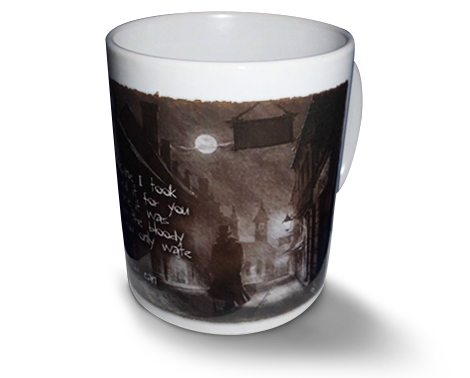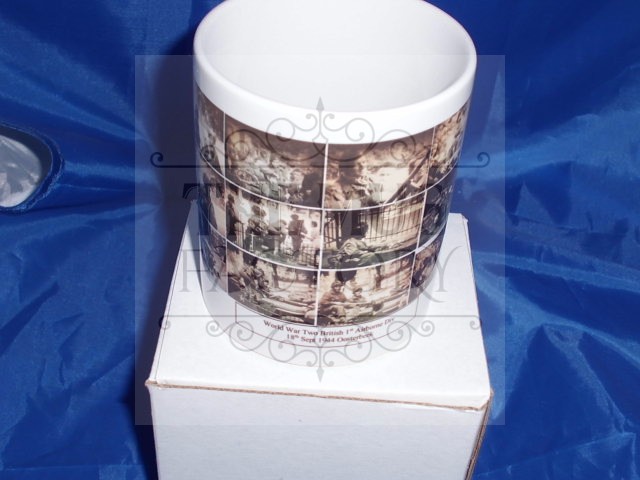18th September 1944 Ooserbeek Tribute military mug
18th September 1944 Ooserbeek Tribute mug
Featuring original images from operation market garden British 1st Airborne Reece, Parachute regiment and 2nd battalion south Staffordshire regiment
Second World War British airborne forces consisted of the Parachute Regiment, the Glider Pilot Regiment, the airlanding battalions and from 1944 the Special Air Service Brigade. Their formation followed the success of the German airborne operations, during the Battle of France. The British Prime Minister, Winston Churchill, directed the War Office to investigate the possibility of creating a corps of 5,000 parachute troops.
On 22 June 1940, No. 2 Commando was turned over to parachute duties and on 21 November, re-designated the 11th Special Air Service Battalion, with a parachute and glider wing. It was 38 men of this battalion who on 10 February 1941 took part in Operation Colossus the first British airborne operation. In September, the battalion was re-designated the 1st Parachute Battalion. A request for volunteers for parachute duties provided enough men to form the 2nd, 3rd and 4th Parachute Battalions. The volunteers for glider-borne infantry were formed into airlanding battalions from December 1941.
The success of early British airborne operations prompted the War Office to expand the existing airborne force, setting up the Airborne Forces Depot and Battle School in Derbyshire in April 1942, and creating the Parachute Regiment. The fledgling force received another boost following the German success in the Battle of Crete, when the War Office issued a communiqué.
The Airborne Forces of the British Army consists of the parachute troops and glider-borne troops of all arms of service. Officers and men in any regiment or corps, may apply for transfer to a parachute or glider-borne unit of the Airborne Forces.
By the end of the war the British Army had raised seventeen parachute and eight airlanding battalions. These battalions served in seven parachute brigades, three airlanding brigades and three airborne divisions. Some British battalions served in the Far East with Indian Army formations. One Canadian parachute battalion served in a British parachute brigade and a Polish parachute brigade served with a British division.
Almost all the battalions played some part in British airborne operations. The first of which was a platoon sized operation in Italy. The second a company parachute landing in France. Building experience all the time these operations were followed by three battalion sized parachute landings in Tunisia. Parachute and airlanding brigades carried out landings in Sicily and the south of France. But the pinnacle of British airborne operations, were three divisional landings at Normandy, Arnhem and the River Rhine crossing in Germany.
The British airborne forces were easily identified by their distinctive uniform. The maroon beret, the airborne forces patch of Bellerophon riding the flying horse Pegasus and parachute wings worn on the right shoulder of trained parachutists. On operations, airborne forces wore their own pattern steel helmet instead of the standard British Brodie helmet and after 1942, the camouflaged Denison smock was issued to airborne forces.
The 1st Airlanding Brigade was an airborne infantry brigade of the British Army during the Second World War and the only glider infantry formation assigned to the 1st Airborne Division, serving alongside the 1st and 4th Parachute Brigades.
The brigade was formed in late 1941 during World War II through the conversion of an existing infantry brigade previously stationed in India, the 31st Independent Infantry Brigade. Two of the initial four infantry battalions left in May 1943 to form the new 6th Airlanding Brigade of the 6th Airborne Division and were replaced by a single new battalion, thereby reducing the brigade's strength by one quarter.
The brigade only saw action on two occasions during the Second World War, in Operation Ladbroke, as part of the Allied invasion of Sicily, in July 1943 and later in Operation Market Garden in September 1944. During the second operation, in the fighting around Arnhem, 1st Airlanding Brigade along with the rest of 1st Airborne Division held out against overwhelming German odds, sustaining very heavy losses. Only around 20 percent of the brigade were evacuated south of the River Rhine. The rest had either been killed, were missing or became prisoners of war.
Following the German surrender in mid-1945, 1st Airlanding Brigade were sent to Norway to disarm the German garrison. Later the same year the brigade was disbanded.
On day two, problems in Arnhem forced Hicks to change the divisional plan. Only the 2nd Parachute Battalion had reached the road bridge strong German defences had halted the other battalions so Hicks decided that the Staffords would link up with the 1st Parachute Brigade in an attempt to reach their objective. However, the Staffords also failed to break through the German defenders. Bad weather over England kept the planned second lift on the ground. The first troops did not arrive until 15:00, a delay that gave the Germans time to approach the landing grounds and engage the KOSB in numerous probing attacks on the northern perimeter. At one stage KOSB commanding officer Lieutenant Colonel Payton-Reid led a bayonet charge to clear the Germans from the area. Meanwhile, the Borders were repeatedly attacked from the south of landing zone's 'X' and 'Z', and were eventually forced to call on the 75 mm guns of the 1st Airlanding Light Regiment to break up the attacks. Hicks had previously decided to send the Staffords on the second lift to join their battalion fighting in Arnhem, while he also sent the 11th Parachute Battalion on the same lift to support 1st Parachute Brigade. The KOSB, until then responsible for defending the landing ground, were attached to 4th Parachute Brigade to replace the 11th Parachute Battalion. However they were still responsible for defending landing ground 'L', for the arrival of the Poles gliders on day three. This left only the Borders, No. 2 Wing GPR and the field ambulance under brigade command.
As day three dawned, the Staffords, and the 1st Parachute Battalion attacked at 04:00, their first objective being to link up with the 3rd Parachute Battalion trapped around St Elizabeth's Hospital. The attack failed but allowed Major-General Urquhart to rejoin the division from a position where he had been trapped by the Germans. This allowed Brigadier Hicks to resume command of the brigade, whereupon Urquhart dispatched Colonel Barlow to take over command of 1st Parachute Brigade and co-ordinate the attack in Arnhem. He left in a jeep and was killed in a mortar barrage just outside Arnhem. The 1st Airlanding Brigade, still holding landing zone 'L' for the expected Polish and resupply gliders, then came under attack from the west and north-west. During the night the KOSB had tried to take the high ground at Koepel, but were stopped by heavy machine gun fire and instead dug in. The remainder of 4th Parachute Brigade advancing north of the railway line also encountered a strong German defence line and were unable to progress any further. All three battalions were ordered to withdraw south of the railway line towards Wolfheze. Although the northern most battalion of the KOSB had thus far enjoyed a quiet morning, in the two hours it took them to advance south of the railway, two companies were now cut off and the entire battalion transport lost. Still under fire from the pursuing Germans, the battalions crossed landing zone 'L' just as the third lift gliders were landing. While attempting to unload the gliders the Poles came under fire. Assuming the approaching men were Germans, they opened fire and caused some casualties.
Brigadier P. H. W. Hicks at Arnhem, 1944.
With no one in command, around 100 men, the remnants of the Staffords, along with about 400 troops from the 1st Parachute Brigade, pulled back towards Oosterbeek. Here they were gathered together in an ad hoc formation known as the "Lonsdale Force" after Major Richard Lonsdale who was put in command. The Lonsdale Force deployed to the south-east of Oosterbeek to defend the division's artillery line. Here, as dusk approached, Lance Serjeant John Baskeyfield of the Staffords, although wounded and with the rest of his men dead or wounded, engaged three tanks as they emerged from the woods with his anti-tank gun. He destroyed the first tank and disabled the second before his own weapon was destroyed. Moving to a nearby gun where the crew were already dead, he continued to fight the third tank alone. Shortly after he managed to disable it, he was killed a shell from a German tank. For his actions Baskeyfield received a posthumous Victoria Cross, the highest British military decoration. The KOSB had by now arrived at the perimeter being formed around Oosterbeek and took up positions south of the railway line just north of division headquarters.
By day four, the battalions of the 1st Airlanding Brigade were dispersed over a wide area. While the Borders were to the west on a line from the River Rhine east of Heveadorp to the Heelsum road, the remaining KOSB companies lay to the north with the remnants of the Staffords forming part of Lonsdale Force in the east. Brigade headquarters was established on open ground at the centre of the divisional area. On day five (21 September), defence of the divisional area was divided between the two remaining brigade headquarters. The 1st Airlanding Brigade in the west now commanded the remaining three companies of Borders, the remnants of the KOSB, and what remained of the Royal Engineers, 21st Independent Company, Glider Pilots and Poles. Lonsdale Force Major Robert Henry Cain of the Staffords disabled a tank with a PIAT and then, although wounded by machine gun fire, positioned one of the division's artillery guns and destroyed it. This was the first of a number of actions by Major Cain which led to the award of a Victoria Cross. This second medal for the Staffords meant it became the only British battalion to receive two Victoria Crosses in one battle during the Second World War.
The Germans did not mount an all-out infantry assault on the divisional area, which was under continuous mortar and artillery attack. Instead, each sector was subjected to small scale assaults at times supported by tanks or self-propelled guns. Enemy troops first attacked the Independent Company, then the Borders who were forced off the high ground overlooking the river, and finally the KOSB. The Germans mounted a strong assault following the landing of the 1st Polish Parachute Brigade south of the river beside Driel. This attack forced the KOSB out of their positions, which were only regained after a bayonet charge. Fighting was so fierce that first reports suggested the KOSB had been annihilated, although it turned out that the counter-attack had in fact reduced the battalion's strength to only 150 men.
By day six, 22 September, the battle had settled into a routine of mortaring and small probing attacks at times supported by armoured vehicles and sniper fire. The Poles, dug in south of the river, relieved part of the pressure on the division, as some German forces were diverted to confront them. The following day began in a similar way to previous days with a mortar and artillery bombardment, followed by infantry and armour trying to find a gap in the perimeter. The KOSB, Glider Pilots and the 21st Independent Company who were all defending the brigade area were repeatedly attacked. Furthermore, food and water shortages also took their toll on the men, with foraging parties subjected to sniper fire. On day eight, 24 September, although German attacks continued, the enemy were engaged by artillery of the XXX Corps south of the river and aircraft from the Royal Air Force. This broke up most assaults before they got started.
On 25 September Lieutenant-General Brian Horrocks, commander of XXX Corps, decided not to reinforce the position north of the Rhine and instead prepare for the evacuation of all survivors in Operation Berlin. The evacuation took place on the night of 25–26 September. Of the 2,526 men of 1st Airlanding Brigade that left England for Operation Market Garden, there were 230 killed, 476 evacuated and 1,822 were missing or prisoners of war.
The mugs we use are top quality bright white, Orca coated, and are Dishwasher and Microwave safe, the high quality images are bonded into the surface of the mug, and do not fade or peel off like transfers
GREAT FOR GIFTS, BIRTHDAYS, OR JUST TO ADD TO YOUR MEMORABILIA COLLECTION.
The artwork is created in our offices/workshop, and we are available for custom work. These designs are individually made, not mass produced.
Please note that I take great care in packaging the mugs they are sent in a polystyrene mug box designed to specifically for posting mugs hence the postage costs















